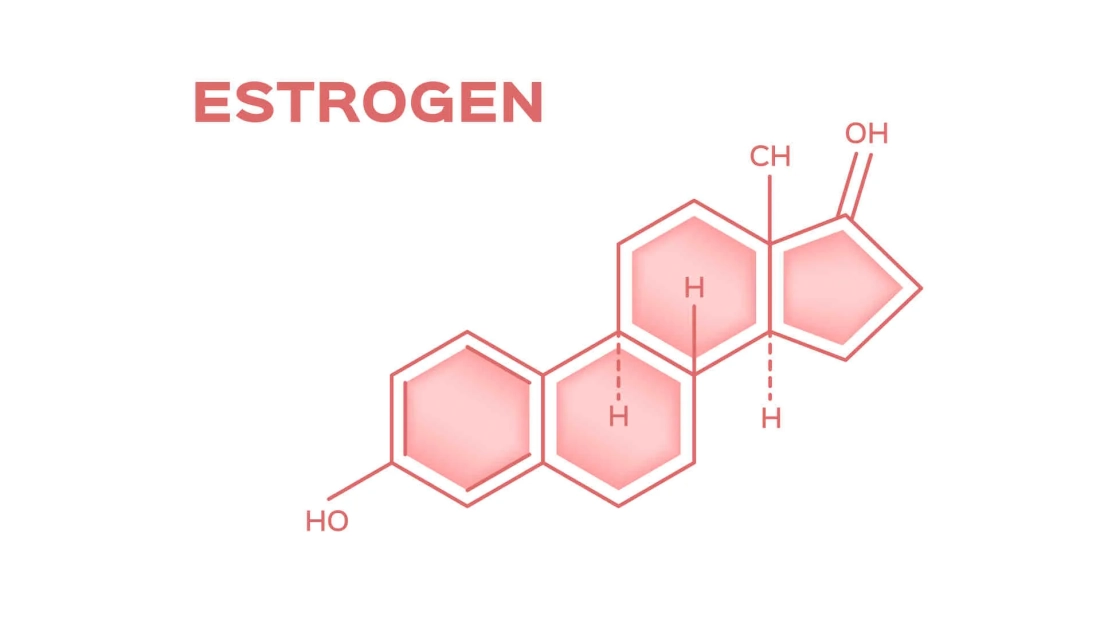Estrogen is an essential hormone in both men and women. Estrogen plays a much more significant role in women and helps in the development of uteruses, breasts, and increases bone density. However, too much estrogen can lead to estrogen dominance which can result in severe consequences from infertility to pelvic pain and autoimmune disease.
Estrogen is regulated by the body through several mechanisms including the metabolism of estrogen and through the hormone progesterone (P4), which we’ll discuss later. Estrogen has 3 forms estrone (E1), estradiol (E2), and estriol (E3). Of the three, E1 peaks after menopause and can be converted into E2, E3 and is the weakest estrogen. E2 is the most prevalent in premenopausal women (women aged 18 – 45 years old) and is the most potent form of estrogen. Although E3 is the least common form of estrogen in the female body, it is the second most potent form. E3 spikes during pregnancy and drops off after menopause along with E2. Estrogens, mainly E2 and E3 help with many things such as preparing the uterus for fertile eggs, helping build bone density in women, and the development of breasts and other primary and secondary sex characteristics in women.
Estrogen is a type of steroid hormone that acts on the nucleus of cells to induce certain actions such as the proliferation of certain target cells. Progesterone is another steroid hormone that can help balance estrogen’s effects. P4 can often be seen in the endometrium tissue of the uterus. E2 binds to ESR1 and ESR2 receptors on the endometrium tissues causing proliferation while P4 will bind to the PGR receptor which will inhibit the expression of ESR11. This helps keep estrogen in check and stops it from causing too much growth and inflammation of the endometrium. Another mechanism used to balance estrogen is through metabolism, where estrogen is broken down and renally excreted3.
Estrogen dominance is when estrogen levels are left unchecked either by not being appropriately metabolized, progesterone-resistant development, or low progesterone1. This can lead to severe health issues:
- gallbladder disease
- fibrocystic breast problems
- Endometriosis
- Infertility
- menstrual irregularities
- polycystic ovary syndrome
- premenstrual syndrome
- cervical dysplasia
- some autoimmune diseases such as Hashimoto, and systemic lupus erythematosus rheumatoid arthritis.
In the case of endometriosis, E2 induces epithelial proliferation of the endometrium of the uterus. This normally helps prepare a more fertile environment in the uterus for any fertile eggs. However, if these cells become progesterone resistant, and progesterone is no longer able to inhibit the ESR1 receptor, estrogen will continue inducing epithelial proliferation. This continued proliferation will lead to growth outside of the uterus which can evolve to endometriosis causing infertility and pelvic pain1.
Estrogen dominance has also been shown to affect thyroid hormones, decreasing the conversion of thyroxine (T4) to triiodothyronine (T3) in cells. Normally T4 is released from the thyroid gland and travels throughout the body to its target cells. Here, these cells will cleave off an iodine molecule converting the T4 to the active T3 form. Estrogen can also aid in the growth of some atypical cells that form leiomyomata or fibroids3. This often affects postmenopausal women. Progesterone decreases significantly after menopause but can affect menstruating women as well. Some postmenopausal women will take estrogen replacement therapy to help with menopausal symptoms, however, they should also take progesterone to prevent estrogen dominance. Premenopausal women can take gonadotropin-releasing hormone (GnRH) antagonists, which will stop the ovaries from overproducing estrogen. For GnRH stimulates the release of luteinizing hormone (LH) and follicle-stimulating hormones (FSH) which increases estrogen production in women. Therefore, GnRH antagonists would counteract this effect.
Several things can cause estrogen dominance and it isn’t fully understood; however, we do know it can have a negative impact on a women’s health. Taking progesterone can be helpful to premenopausal and postmenopausal women. Diindolylmethane (DIM) can also help women by increasing the metabolism of estrogen and excreting it from the body. DIM, increases the metabolism of estrogen into the molecule, 2-hydroxyestrogen which has less estrogenicity (estrogen activity). This metabolism to 2-hydroxyestrogen is important because it avoids the conversion of the more active metabolite 16A-hydroxyestrone,4 which has potential connections to breast cancer. Supplements and medications are not always required though, simple things and lifestyle changes can help. Such as a nutritious diet that is high in fiber and low in fat, reducing stress, and limiting or eliminating alcohol can all provide significant benefits.
By: Houston Swann, Pharm. D. Student
Edited by: Jimmy Stevens, Pharm. D. and Madison Stevens, Pharm. D.
References:
1.) Marquardt, R., Kim, T. H., Shin, J.-H., & Jeong, J.-W. (2019, August 5). Progesterone and estrogen signaling in the endometrium: What goes wrong in endometriosis?. MDPI. https://www.mdpi.com/1422-0067/20/15/3822
2.) professional, C. C. medical. (n.d.). High estrogen: Causes, symptoms, dominance & treatment. Cleveland Clinic. https://my.clevelandclinic.org/health/diseases/22363-high-estrogen
3.) Warshowsky, A. (n.d.). Uterine Fibroids (Leiomyomata) . Retrieved June 19, 2023,. https://www-clinicalkey-com.ezproxy3.library.arizona.edu/#!/content/book/3-s2.0-B9780323777278000574?scrollTo=%23hl0000219
4.) Smith, S., Sepkovic, D., Bradlow, L. H., & Auborn, K. J. (2008, December 12). 3,3´-Diindolylmethane and Genistein Decrease the Adverse Effects of Estrogen in LNCaP and PC-3 Prostate Cancer Cells. https://www-sciencedirect-com.ezproxy3.library.arizona.edu/science/article/pii/S0002934315007743
